{ DOWNLOAD AS PDF }
 ABOUT AUTHORS
ABOUT AUTHORS
Devender Sharma*1, Kajal V. Kosankar2,
1Hi – Tech College of Pharmacy, Chandrapur, Maharashtra (India)
2Smt. Kishoritai Bhoyar College of Pharmacy, Kamptee, Nagpur, Maharashtra (India).
*sdevender350@gmail.com
ABSTRACT
“Green tea in green world” it means that healthy green tea in healthy world. As we know when leaves are in green color they are considered as they are fresh and healthy to use. Tea, it is present in two forms that is green or black tea, it is consumed most widely in the world. Extracts of tea leaves it is supplied in the dietary supplements which will maintain the health. However, this review shows an interest in the health care properties of green tea which will help in treatment of cancer which is more dangerous cannot be cure easily. The comparison between black and green tea is given which will help to make a choice. Green tea contains catechins which is an important chemical constituents it shows biological activity like antioxidant, anti-angiogenesis, and anti-proliferative effects and also in treatment of various forms of cancer. This review has much more focus on the biological properties like catechin, epigallocatechingallate (EGCg) show effects on antitumor properties and other health benefits. The antioxidant properties of green are responsible to improvement in cardiac health, atherosclerosis and it has powerful effects on the body. Catechins may reduce cholesterol levels in blood and also improve brain function. The studies show that when caffeine and L-theanine have synergistic effects. Green tea shows fat oxidation about increased by 17%. Green tea contains approximately 20-40% polyphenols and 60-80% catechins such as EGCG by weight. Synergistic properties of polyphenolicconstituents are increasing now a day that are important in medicinal benefits. Tea is now finding its way into topical preparations like patches. The uses of green tea are clinically proved.
[adsense:336x280:8701650588]
Reference Id: PHARMATUTOR-ART-2568
|
PharmaTutor (Print-ISSN: 2394 - 6679; e-ISSN: 2347 - 7881) Volume 6, Issue 3 Received On: 23/12/2017; Accepted On: 05/01/2018; Published On: 01/03/2018 How to cite this article: Sharma D, Kosankar KV; Green Tea in Green World an updated review; PharmaTutor; 2018; 6(3); 9-16; http://dx.doi.org/10.29161/PT.v6.i3.2018.9 |
INTRODUCTION
Green tea it is of fresh or dried leaves of Camellia sinensisthis nameis derived from Latinized name which belongs to family Theaceaethat have not undergone withering and oxidation process used to make oolong and black tea. Green tea originated in China, but its production has spread in many countries like Asia. (Crespy et al., 2004) It results in the preservation of the color& act as antioxidants when taken in high concentration (Chow et al., 2003). The brands are used like GNC herbal plus, Typhoo,Tetley, Happy valley, Lipton which more used for lowering the risk of fats. The classification of green tea is given below
|
Classification |
|
|
Kingdom |
Plantae-Plants |
|
Subkingdom |
Tracheobionta-Vascular plants |
|
Superdivision |
Spermatophyta–Seed plants |
|
Division |
Magnoliophyta-flowering plants |
|
Class |
Magnoliopsida-dicotyledons |
|
Subclass |
Dilleniidae |
|
Order |
Theales |
|
Family |
Theaceae-tea family |
|
Genus |
Ceamellia L. –camellia |
|
Species |
Cemelliasinensis(L.) Kunze–Tea |
History and Origin(Chow et al., 2003)
Green tea was first steeped in 2737 BC during the reign of Emperor Shennong – a mythical sage and it has become popular mythology of Chinese agriculture and medicine. (Hong et al., 2002)
It is said that during one of his travels, shennong and his member got tried so, they decided to stop and take a rest, few tea leaves fell into his cup of hot water from a burning tea twig that lay nearby. The water turned dark in color, but it was unnoticed by the emperor, without noticing they had that hot water containing tea leaves. When he consumed this water, he found it to be extremely refreshing and requested the members of this convoy to prepare once again. (Emily et al., 2012)
This event was an important in the history of teas, especially the history of Green tea, since this was first recorded instance of tea being brewed and consumed.
1. However, some cultural historians trace back the history of Green tea as far as 3000 years ago when fresh tea leaves were chewed and eaten by the people because of their good experience they decided to grow it all over Southeast Asia. (Imai et al., 1997)
2. Formalized “tea ceremonies” took shape and tea drinking became very important in social life of people of China. It was during this era that the process of “steaming”the tea leaves was developed and refined. (Maeda et al., 2013)
3. Steaming – a method is much more universally associated with the production of Green tea. Steaming is the process of enzymatic oxidation– which causes the darkening of the tea leaves when they are added with hot water– and this allows the leaves to remain in natural “green” state.
4. Today, most high-quality Green teas are steamed and/or pan-fired – a technique where as thefresh Green teas are roasted in a large wok on high heat for a short period of time for extraction of leaves component into hot water.
5. Today, India has become one of the largest tea producers in the world, although about 70% of tea is consumed within India itself.
6. Again it also stands at the top 5 per-capita tea consumer and renowned teas such as assam and Darjeeling this are grown in India.
7. Tea production, certification, exportation, and all other facets which are important for trade in India that has been controlled by the Tea Board of India.
8. Country of origin is – china; region of origin is – East Asia
Macroscopic and microscopic characters (Nakachi et al., 2000)
Macroscopic:
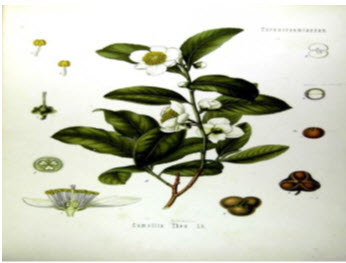
Camellia sinensis this belongs to Tibet, China, and Japan. Youngest leaves are delicately serrated, narrow, smooth with fine hairs, downy, and but slightly serrated. Its size is about 1-2 m tall and they are serrated, but venation little perceptible. Leaves of medium and large sizes strongly, deeply, and widely serrated, with well-marked venation, and margin to the leaves are present, but they are thick and hard so it is difficult to identify veins in the lamina a series. The leaves are elliptic and it has obtuse end(Nagano et al., 2001). The Assam tea plant belongs to north east India. Odor is characteristic, taste is drying and astringent. This leaves have short hairs pointed and undivided.
Microscopic:
Transverse Section: (Saito et al., 2011)
1. The upper epidermis consists of cells with undulating walls and covered with thick cuticle and lower epidermis consists of smaller cells and provided with actinocyticstomata.
2. With the variety of tea and age of the leaf; they are unicellular, tapering and thick wall, varying in length of Greentea, but often attaining 500-700 microns.
3. The mesophyll is heterogeneous and asymmetrical. It is identified by the presence of a large number of sclerenchymatousidioblasts.They vary in shape and in thickness of the walls.
4. The cells of spongy parenchyma contain cluster crystals of calcium oxalate and midrib is biconvex. Under each epidermis there is a layer of collenchyma.
5. The wood is surrounded by a pericycle consisting of slightly lignified cells arranged in circle.
6. The little fragments of the stems, which are found in ordinary tea, they are slightly different in structure and it forms a circle within the pith containing branched idioblasts; these have comparatively thin, pitted walls.
7. Macroscopicand microscopic character analyzed by optical microscopy and fragments by scanning electron microcopy.
Types of green tea (Harold et al., 1992)
The types of green tea are classified on the basis of color of finished leaves, color of tea liquor and % of oxidation during processing. The chinese are the first people who has made many of the drinks according to that they had classified the tea into different types such as green tea, yellow tea, white tea, oolong tea, black tea, dark tea. Among this type of teas some of them are flavored, scented, aged, decaffeinated or ground etc.
|
Moderately lower in price |
Higher in price |
|
Gunpowder Green tea: Comes from china in the form of small pellets and used as dental carries |
Sencha Green tea: Smaller has natural sweetner |
|
Bancha Green tea:(Genmaicha) Slightly stronger, more astringent taste gives refined flavor |
Matcha Green tea: Traditional Japanese Green tea ceremonies |
|
China Green tea: Subtle flavor more used as good standard everyday |
Gyokuro Green tea: It is one of the highest grades of tea available and may not be offered at your local tea store |
Production of green tea (Van et al., 2004)
Growing, harvesting and processing of green tea:
1. Green tea is processed and grown in a variety of ways depending on type of Green tea and these results in maximum amount of polyphones& volatile organic compounds affects aroma and taste.
2. Leaves and leaf buds are used to produce chinese tea.
3. Growing at altitudes about 7000 feet from sea level, the conditions are -In the sun and under the shade.
4. Soil conditions range from sandy loam to heavy clay and the trees are grown about 25 feet in height.
5. Leaves and leaf bud that are plucked during harvesting; this are done in 3 times per year 1st April to early June, 2nd June to July,3rd late July to early August.
6. Green tea processed using either artisanal methods -sun-drying, basket or charcoal firing or pan firingor modern methods-oven drying, tumbling, or steaming.
7. Plucking capacity is about 16-25kg they are stored under low humidity refrigeration in 30 to 60 kg paper bags at 0-50C.
8. Green tea processed using either artisanal methods -sun-drying, basket or charcoal firing or pan firingor modern methods-oven drying, tumbling, or steaming.
9. Stored under low humidity refrigeration in 30 to 60 kg paper bags at 0-50C. The amount of yield is about 4-6kg which is said to be finished tea.
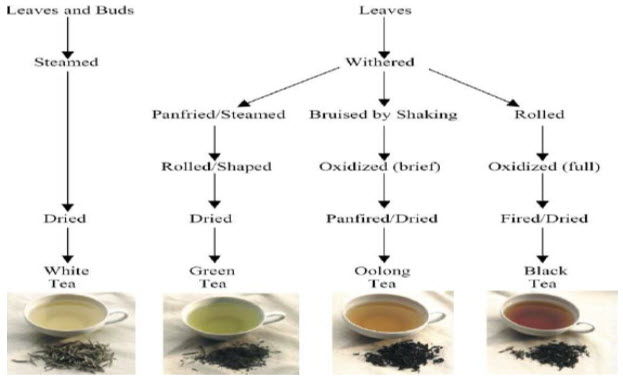
Health benefits of green tea that have been confirmed in human studies
Green tea contains bioactive compounds that improve health: (Sharma et al., 2009)
a.It contains polyphenols like flavonoids and catechins, which act as powerful antioxidants.
b.Green tea is the antioxidant EpigallocatechinGallate(EGCG), which treat various diseases.
Green tea can improve brain function & make smarter:
Caffeine (stimulant) it produce a response without causing the “jittery”.
a. L-thiamineincreases the activity of the inhibitory neurotransmitter GABA and anti-anxiety effects.
b. Caffeine and L-thiamine can have synergistic effects. The combination of the two is potent for improving brain function.
Green tea increase fat burning and improves physical performance: (Laurie et al., 2005)
a. Fat burning and boost the metabolic rate.
b. Weight loss because of its thermogenic properties that promote oxidation.
c. Caffeine show to improve mobilizing of fatty acids from the fat tissues and used as energy.
Antioxidants used to lower risk of various types of cancer: (Proctor et al., 2005)
a. Cancer is caused by uncontrolled growth of cells leads to causes death and antioxidants give protective effect.
b. Green tea is an excellentsource of powerful antioxidants, so itreduce risk of cancer.
Green tea may protect brain in old age, lowering risk of Alzheimer’s and Parkinson’s:
a. Catechinhave various protective effects on neurons and animal models and lowering the risk of Alzheimer‟s and Parkinson‟s.
b. It refreshes the body, CNS, skeletal muscles, heart and liver.
Green tea can kill bacteria, improves dental health and lower risk of infection:
a. Streptococcus mutantsare harmful bacteria which cause harm to mouth. It causes plaque formation and is a leading contributor to cavities and tooth decay.
b. Catechinscan inhibit the growth of streptococcus mutants.
c. It prevent strep throat and influenza and stop cavities
Green tea may lower risk of diabetes:
a. Green tea can improve insulin sensitivity and lower the risk of diabetes. Green tea had a 42% lower riskof developing type II diabetes.
b. Diabetes it is caused by more secretion of insulin from beta cells. Green tea is more sensitive towards insulin.
Green tea may reduce risk of cardiovascular disease:
a. Green tea increases the antioxidant capability of the blood, which protects the LDL and HDL cholesterol. Green tea drinkers have up to a 31% lower risk of cardiovascular disease.
b. LDL and VLDL get deposit on blood vessels wall and that leads to cause atherosclerosis. Green tea helps to lower this risk.
Green tea can help in weight loss: (Inoue et al., 2011)
a. Several studies show that green tea leads to decreases in body fat, especially in the abdominal area.
b. When there is accumulation of fat it is responsible to cause many diseases.
Green tea may reduce crohn’s disease:
It reduces inflammation which has been caused by crohn’s disease and ulcerative colitis, two types of inflammatory bowel disease and it also cure viral inflammation of liver.
Green tea may decrease risk of dying and help to live longer:
a. Green tea drinkers are at a lower risk of cardiovascular disease and cancer, it makes sense that it could help live longer.
b. It also impaired immune function and herbal treatment is given to rheumatoid arthritis.
c. Death of all causes: 23% lower in women, 12% lower in men.
d. Death from heart disease: 31% lower in women, 22% lower in men.
Side Effects(Brown et al., 1999)
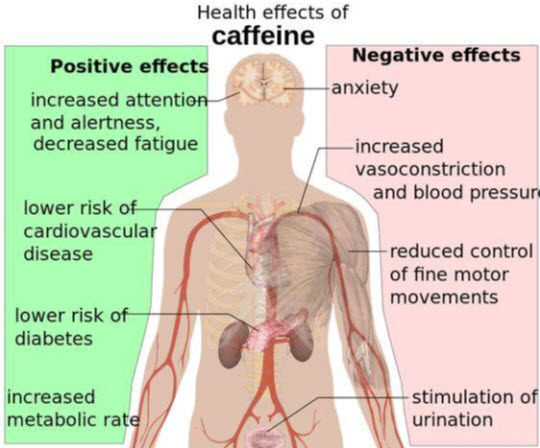
a. Sleep problems nervousness and anxiety
b. Irregular or accelerated heartbeats
c. Vomiting
d. Diarrhoea
e. Iron Deficiency & anemia mild to serious headaches
f. Muscle tremors & contraction , heartburn
g. Dizziness
h. Pregnancy & infant health risk
i. Liver disease
j. Abdominal pain
k. Heart problems
l. Kidney disorder
m. Psychological disorders
NOW YOU CAN ALSO PUBLISH YOUR ARTICLE ONLINE.
SUBMIT YOUR ARTICLE/PROJECT AT editor-in-chief@pharmatutor.org
Subscribe to Pharmatutor Alerts by Email
FIND OUT MORE ARTICLES AT OUR DATABASE
Green Tea Interaction
Highly interaction:
Amphetamines and cocaine:
Taking green tea along with stimulant drugs might cause increased heart rate and high blood pressure. Avoid taking stimulant drugs along with caffeine. It shows usually unstable heart rhythm.
Ephedrine:
It cause stimulation and sometimes serious side effects and hear problems. Do not take caffeine-containing products and ephedrine at the same time.
Moderately Interaction: (Béliveau et al., 2004)
Adenosine:
The caffeine in green tea might block the effect of adenosine.
1. Antibiotics (Quinolone antibiotics):
Some antibiotics that decrease quickly and body breaks down caffeine include ciprofloxacin, enoxacin, norfloxacin,parfloxacin, trovafloxacin, and grepafloxacin beta –lactam reducing bacterial resistance to treatment.
2. Oral contraceptives:
Some birth control pills include ethinyl estradiol and levonorgestrel, ethinyl estradiol and norethindrone. If it is for longer time in body it will show stimulating effects.
3. Cimetidine:
It shows caffeine side effects including jitteriness, headache, fast heartbeat, and others.
4. Disulfiram:
Taking green tea (which contains caffeine) along with disulfiram might increase side effects of caffeine including jitteriness, hyperactivity, irritability, and others.
5. Propranolol and metaprolol:
It may increase blood pressure along with caffine and this used to cure high blood pressure and heart disease.
6. Nicotine:
It causesserious problems including increased heart rate and high blood pressure.
7. Aspirin:
Warfarin with green tea which contain vitamin K and due to this, it will show warfarin ineffective.
8. Lithium:
This medicine is used in manic and depression it reduces blood level of lithium due to green tea.
9. Pentobarbital:
The stimulant effects of the caffeine in can block the sleep-producing effects of pentobarbital.
Slightly Interaction: (Yang et al., 2001)
1.Alcohol:
Taking green tea along with alcohol might cause too much caffeine in the bloodstream and caffeine side effects including jitteriness, headache, and fast heartbeat.
2.Fluconazole:
Taking fluconazole (Diflucan) along with green tea might increase the risk of side effects such as nervousness, anxiety, and insomnia.
3.Terbinafine:
Taking green tea along with terbinafine (Lamisil) can increase the risk of caffeine side effects including jitteriness, headache, increased heartbeat, and other effects.
Formulation available in market
Green tea in transdermal formulation: HPLC method for quality control & in vitro drug release:
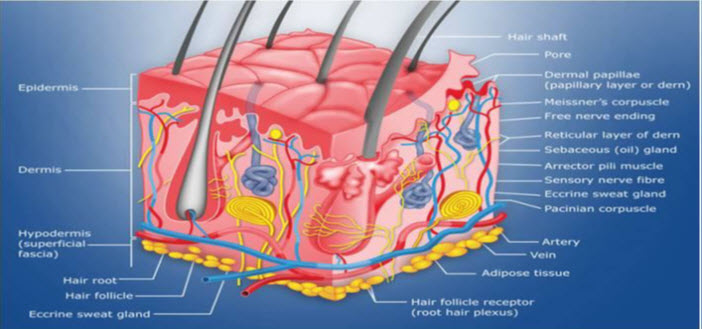
a. The RP-HPLC method used to determination caffine, gallic acid and EGCG in green tea transdermal emulsion and the requirements listed in the ICH guidelines.
b. EGCG will be able to show its biological activities systemically when used from green tea transdermal emulsion.
c. This gives effective penetration rate into skin.
Antioxidant and anti inflammatory used in skincare formulation: (Cooper et al., 2005)
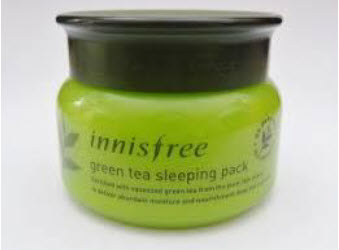
1. The antioxidant which is present in green tea is used for cleansing with japanese green tea, try antioxidant cleanser, morning cleanser, or evening cleanser.
2. It acts as cleansing and anti-aging benefits are seen in a single treatment, try renovation mushroom mask – rich in cleansing bentonite clay, exfoliating mushroom enzymes, and age-fighting botanicals that include japanese green tea.
Green tea chewing gum:
1. The chewable gums give suitable taste and have ability to produce antioxidant effects.
2. Fresh leaves extraction is done (maceration). Caffine, catechin, and flavonoids are measured.
3. Chewing gums are made by adding different types of sweeteners, flavoring agents, various gums bases.
Effervescent green tea extracts formulation: (Zaveri et al., 2006)
A. The dosage form of effervescent tablet is more advantageous or granules are dispensed in a liquid to release the desired extractive agents, such as polyphenols (catechins), in the formulation.
B. The liquid dosage form speeds the absorption rate of extract in the body.
C. Further, by including effervescence causing ingredients, an effervescent action will be created upon the deployment of the formulation in a liquid.
D. Therefore, the extracts are more exposed to the digestive forces inside the body and absorbed in greater rate.
|
Formulation |
Composition (%, w/w) |
|
Green tea extracts |
10 -50 |
|
Sodium bicarbonate |
5 -30 |
|
Anhydrous citric acid |
10 -45 |
|
Polyethylene glycol 6000 |
1 –10 |
|
Polyvinyl pyrrolidone |
1 -10 |
|
Flavor agent |
0.1 -3 |
An advanced green tea supplement to aid in weight loss:(Zaveri et al., 2006)

1. Green tea gives overall health enhancing supplement. Found in many fat burner diet formulas, green tea provide a gentle metabolic boost while also providing you with a little extra energy. This supplement is heart healthy and boosts essential benefits for women and men alike.
2. Green Tea Extract contains our special blend of Green Tea and Vitamin C. Green Tea extract give weight loss, lower the risk of heart disease and lower cholesterol all without jittery and shaky feeling of Green Tea.
3. Vitamin C and Green Tea have been shown to improve immune system and heart health, making this a powerful supplement.
NOW YOU CAN ALSO PUBLISH YOUR ARTICLE ONLINE.
SUBMIT YOUR ARTICLE/PROJECT AT editor-in-chief@pharmatutor.org
Subscribe to Pharmatutor Alerts by Email
FIND OUT MORE ARTICLES AT OUR DATABASE
Glucose lowering effect of green tea formulation:(Zaveri et al., 2006)
1. The present invention relates to lowering blood glucose, which contains a polyphenols extracted, isolated, and purified from green tea, and calcium, as active ingredients.
2. The inventive composition shows a synergistic blood glucose-lowering effect by the green tea polyphenols and the calcium, and it show useful for diabetic patients.
Current research going on green tea
1. Blood and urine level of tea catechin after ingestion of different amount of green tea by human volunteers.
2. Pharmacokinetics & safety of green tea polyphenols after multiple – dose administration of epigallocatechine.
3. Study of green tea consumption & cancer risk in women.
4. Study of green tea extract in patient with advanced lung cancer.
5. Cross sectional study of effect of drinking green tea on cardiovascular disease& liver disease.
6. Bioavailability & antioxidant activity of tea, black tea, or green tea extract supplement.
7. Green tea inhibits vascular endothelial growth factor (VEGF) induction in human breast.
Summary
1. Overall, our findings suggest that green tea consumption is good for health which gives more beneficial effects.
2. The green tea is used in daily life which acts as powerful supplement for the consumer
3. Macroscopic & microscopic studies show its physical nature and its organoleptic characters of leaves which contain chemical constituents which is beneficial to treat several diseases.
4. The thin section shows internal part of the leaves by using scanning electron microscopy which is responsible to generate secondary electrons.
5. Tea contains polyphenols, especially (−)-epigallocatechin-3-gallate (EGCG), which is an active ingredient in green tea, which have been shown to have antimutagenic, antigenotoxic, and anticarcinogenic properties .
6. Higher consumption of green tea shows many harmful side effects. It may also interaction with stimulant drugs.
7. Since flavones in green tea have strong antioxidant properties, consuming green tea may give protection from oxidative stress, and it shows inhibition of cancer development.
8. The studies on green tea have shown a correlation between daily consumption of green tea which is lower the risk of death from cardiovascular disease.
9. Differences in tea preparation which may result in different bioactivity of green tea consume between countries.
10. Green tea contains antioxidants and anti-inflammatory activity due to this many formulations are made which protect skin, where the tea extract show weight loss.
CONCLUSION
Laboratory studies showed the health effects of green tea. As the human clinical evidence is still limited, future research needs to define the actual magnitude of health benefits, establishes the safe range of tea consumption associated with these benefits, and elucidates the mechanisms of action.Development of more specific and sensitive methods with more representative models along with the development of good predictive biomarkers will give a better understanding of how green tea interacts with endogenous systems and other exogenous factors. Definitive conclusions concerning the protective effect of green tea have to come from well-designed observational epidemiological studies and intervention trials. The development of biomarkers for green tea consumption, as well as molecular markers for its biological effects, will facilitate future research in this area. This study demonstrates the benefits of green tea for its anti-inflammatory and anti-oxidant potential. It has been used to treat cardiovascular disease, oral cavity disease and Parkinson’s disease. There is also a wide range of uses for green tea in diabetes, exercise, enhancement, and inflammatory bowel disease and skin disorders. Daily, drink of green tea which will keep away from many diseases most important cancer which cause death. Moderate, regular and habitual consumption of green tea is safe.
REFERENCES
1. Crespy V, Williamson. A review of the health effects of green tea catechins in in vivo animal models in Pubmed, 2004 Dec;134(12 Suppl):3431S-3440S.
2. Chow HH, Cai Y, Hakim IA, Crowell JA, Shahi F, Brooks CA. Pharmacokinetics and safety of green tea polyphenols after multiple-dose administration of epigallocatechingallate and polyphenon E in healthy individuals. Clin Cancer Res 2003; 9:3312-3319.
3. Hong J, Lu H, Meng X, Ryu JH, Hara Y, Yang CS. Stability, cellular uptake, biotransformation, and efflux of tea polyphenol (−)-epigallocatechin-3-gallate in ht-29 human colon adenocarcinoma cells. Cancer Res 2002; 62:7241-7246.
4. Emily Creasy. Negative Benefits of Green Tea for Dieting Last Updated, 2013, 16. 17. Jurgens TM, Whelan AM, Killian L, Doucette S, Kirk S, Foy E. Green tea for weight loss and weight maintenance in overweight or obese adults, The Cochrane Database of Systematic Reviews, 2012.
5. Maeda-Yamamoto M. Human clinical studies of tea polyphenols in allergy or life style-related diseases, Current Pharmaceutical Design. 2013; 19(34):6148-6155.
6. Imai K, Suga K, Nakachi K. Cancer-preventive effects of drinking green tea among a Japanese population. Prev Med 1997; 26:769-775.
7. Nakachi K, Matsuyama S, Miyake S, Suganuma M, Imai K. Preventive effects of drinking green tea on cancer and cardiovascular disease: epidemiological evidence for multiple targeting prevention. Biofactors 2000; 13:49-54.
8. Nagano J, Kono S, Preston DL, Mabuchi K. A prospective study of green tea consumption and cancer incidence, Hiroshima and Nagasaki (Japan). Cancer Causes Control 2001; 12:501-508.
9. Sharma DN, Barrett ML, Chavez ML, Gardiner P, Ko R, Mahady GB et al. Safety of green extracts: A systematic review by the US pharmacopeia. Drug Saf 2009; 31:46984.
10. Proctor GB, Pramanik R, Carpenter GH, Rees GD. salivary proteins interact with dietary constituents to modulate tooth staining. J Den Res 2005; 84:73-8.
11. Laurie SA, Miller VA, Grant SC, Kris MG, Ng KK. Phase I study of green tea extract in patients with advanced lung cancer. Cancer ChemotherPharmacol 2005; 55:33-38.
12. Inoue H, Akiyama S, Maeda-Yamamot M, Nesumi A, Tanaka T, Murakami A. High-dose green tea polyphenols induce nephrotoxicity in dextran sulfate sodium-induced colitis mice by down-regulation of antioxidant enzymeandheat-shock protein expressions. Cell Stress Chapter ones 2011; 16:653-662.
13. Saito M, Nemoto T, Tobimatsu S, Ebata M, Le Y, Nakajima K. Coffee consumption and cystatin-C-based estimated glomerular filtration rates in healthy young adults: Results of a clinical trial. J NutrMetab. 2011, 146-865.
14. Harold N, Graham PD. (Green tea composition, consumption and polyphenol chemistry. Prev Med 1992; 21:334-50.
15. Van Wyk BA, Wink M. Medicinal Plants of the World; Timber Press: Portland, OR, USA, 2004.
16. Brown MD. Altern Med Rev. Green tea (Camellia sinensis) extract and its possible role in the prevention of cancer 1999; 4:360-370.
17. Béliveau R, Gingras D. Green tea. Prevention and treatment of cancer by nutraceuticals. Lancet 2004; 364:1021-1022.
18. Yang M-H, Wang C-H, Chen H-L. Green, oolong, and black tea extracts modulate lipid metabolism in hyperlipidemic rats fed high-sucrose diets. J NutrBiochem 2001;12:14–20.
19. Cooper R, Morre J, Morre D. Medicinal Benefits of Green Tea: Part I. Review of Noncancer Health Benefits. J Alternat Complement Med . 2005; 11(3): 521-28.
20. Zaveri N. Green tea and its polyphenoliccatechins: Medicinal uses in cancer and noncancer applications. Life Sciences. 2006; 78: 2073-2080.
NOW YOU CAN ALSO PUBLISH YOUR ARTICLE ONLINE.
SUBMIT YOUR ARTICLE/PROJECT AT editor-in-chief@pharmatutor.org
Subscribe to Pharmatutor Alerts by Email
FIND OUT MORE ARTICLES AT OUR DATABASE











